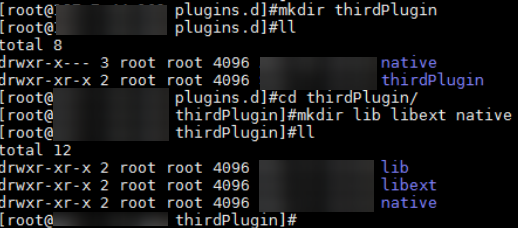How Do I Develop a Third-Party Flume Plug-in
- Install the Flume client, for example, in the /opt/flumeclient directory.
- Compress the self-developed code into a JAR package.
- Create a directory for the plug-in.
- Go to Flume client installation directory/fusionInsight-flume-*/plugins.d and run the following command to create a directory. The directory name can be changed based on the site requirements.
cd /opt/flumeclient/fusioninsight-flume-1.9.0/plugins.d
mkdir thirdPlugin
cd thirdPlugin
mkdir lib libext native
The command output is displayed as follows:

- Place the third-party JAR package in Flume client installation directory/fusionInsight-flume-*/plugins.d/thirdPlugin/lib. If the JAR package depends on other JAR packages, place the dependent JAR packages in Flume client installation directory/fusionInsight-flume-*/plugins.d/thirdPlugin/libext. Stores local library files in Flume client installation directory/fusionInsight-flume-*/plugins.d/thirdPlugin/native.
- Go to Flume client installation directory/fusionInsight-flume-*/plugins.d and run the following command to create a directory. The directory name can be changed based on the site requirements.
- Configure the Flume client installation directory/fusionInsight-flume-*/conf/properties.properties file.
For details about how to set parameters in the properties.properties file, see the parameter list in the properties.properties file in the corresponding typical scenario Configuring a Non-Encrypted Flume Data Collection Task and Configuring an Encrypted Flume Data Collection Task.
Feedback
Was this page helpful?
Provide feedbackThank you very much for your feedback. We will continue working to improve the documentation.






